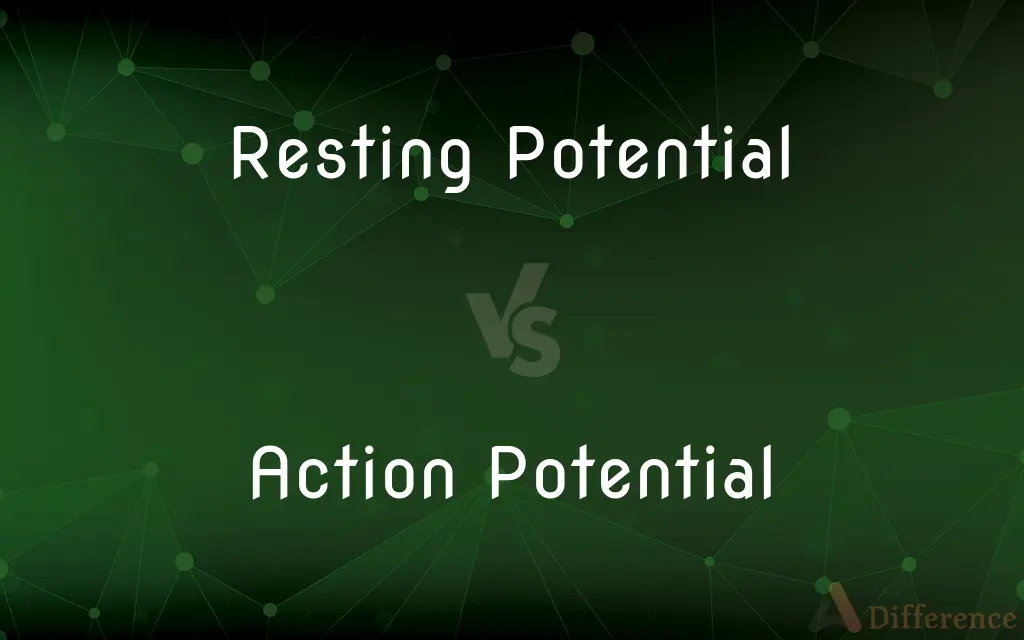Resting Potential vs. Action Potential — What's the Difference?
By Tayyaba Rehman — Published on January 14, 2024
Resting potential is the stable electric charge of a neuron at rest, while action potential is a brief electrical impulse that travels along a neuron, enabling cell communication.

Difference Between Resting Potential and Action Potential
Table of Contents
ADVERTISEMENT
Key Differences
Resting Potential: Resting potential refers to the electrical charge difference across the cell membrane of a neuron when it is at rest. In this state, the neuron is not actively sending signals. The resting potential is maintained by ion channels in the membrane, which selectively allow ions (such as potassium and sodium) to pass in and out. The neuron is negatively charged inside compared to the outside, typically around -70 millivolts. This stable charge provides the baseline for neuron activity.
Action Potential: Action potential is a rapid and temporary change in the electrical charge of a neuron's membrane. It occurs when the neuron is stimulated and reaches a certain threshold of depolarization. At this point, voltage-gated ion channels open, allowing a rapid influx of sodium ions, leading to a reversal of the charge. This generates an electrical impulse that travels along the neuron's axon. Action potentials are the basis of neuronal communication and are essential for transmitting signals within the nervous system.
State: Resting potential is the neuron's baseline, stable charge at rest, while action potential is a transient and rapid electrical impulse during neuron activation.
Function: Resting potential prepares the neuron for action, while action potential is the actual signal transmission.
Magnitude: Resting potential is typically around -70 mV, while the peak of action potential can reach around +40 mV.
ADVERTISEMENT
Duration: Resting potential is continuous, whereas action potential is brief, lasting only milliseconds.
Usage in Neuronal Communication: Neurons transition from resting potential to action potential when they receive a stimulus. Action potentials propagate along the neuron's axon, allowing communication with other neurons or target cells.
Comparison Chart
State
Stable, at rest
Transient, during stimulation
Function
Prepares neuron for action
Transmits signals
Magnitude
Around -70 mV
Up to +40 mV
Duration
Continuous
Brief (milliseconds)
Trigger
N/A
Requires depolarization
Compare with Definitions
Resting Potential
It represents the baseline membrane voltage of a neuron.
The resting potential of -70 mV ensures a neuron's readiness for signaling.
Action Potential
Action potential is the neuron's way of transmitting signals to other cells.
The brief but powerful action potential is essential for information transfer in the brain.
Resting Potential
Resting potential is essential for the neuron's responsiveness to stimuli.
Neurons rely on their resting potential to quickly transition to action potential when needed.
Action Potential
Action potential is a rapid electrical impulse in a neuron during stimulation.
Action potentials transmit information in the nervous system, allowing us to think and move.
Resting Potential
Resting potential is the stable electric charge of a neuron at rest.
Neurons maintain resting potential to be ready for action when stimulated.
Action Potential
It involves the temporary reversal of a neuron's charge.
Action potential results from depolarization, turning a negative charge into a positive one briefly.
Resting Potential
It is the resting state of a neuron's membrane potential.
Resting potential is like a charged battery waiting to be used for communication.
Action Potential
It represents a brief change in a neuron's membrane potential.
During action potential, ions flow in and out of the neuron, creating an electrical signal.
Resting Potential
At resting potential, the neuron is negatively charged inside.
The interior negativity of resting potential is crucial for efficient neuronal communication.
Action Potential
Action potentials are like "neuronal messages" that travel along axons.
Nerve cells use action potentials to communicate with muscles, leading to movement.
Common Curiosities
What is the significance of resting potential in neuronal function?
Resting potential prepares neurons to respond quickly to stimuli, enabling rapid signal transmission.
What triggers the transition from resting potential to action potential?
Neurons transition to action potential when they receive a stimulus that depolarizes the membrane.
What is resting potential in a neuron?
Resting potential is the stable electrical charge of a neuron's membrane when it is at rest.
How long does an action potential typically last?
Action potentials are brief, lasting only milliseconds.
What is the membrane potential during resting potential?
Resting potential is typically around -70 millivolts (mV).
How do neurons transition from resting potential to action potential?
Neurons transition to action potential when they reach a threshold level of depolarization.
Can resting potential change?
Resting potential can change if the neuron's ion channels are altered or if it receives input from other neurons.
Do all neurons have the same resting potential and action potential characteristics?
Resting and action potentials can vary slightly between different types of neurons.
Where does action potential occur in a neuron?
Action potential occurs in the axon of a neuron.
How is resting potential maintained in neurons?
Ion channels in the cell membrane selectively allow ions to pass, maintaining the charge difference.
What happens during action potential?
Action potential is a rapid change in membrane potential when a neuron is stimulated, allowing signal transmission.
What initiates the return to resting potential after action potential?
Ion pumps and channels restore the resting potential after action potential.
What would happen if neurons lacked resting potential?
Without resting potential, neurons would not be primed to rapidly respond to stimuli, impairing information processing in the nervous system.
What role does action potential play in neuronal communication?
Action potentials propagate along axons, allowing neurons to transmit signals to other cells.
What is the voltage difference during action potential?
The peak voltage during action potential can reach around +40 mV.
Share Your Discovery

Previous Comparison
Second Language vs. Foreign Language
Next Comparison
Electrovalent Bond vs. Covalent BondAuthor Spotlight
Written by
Tayyaba RehmanTayyaba Rehman is a distinguished writer, currently serving as a primary contributor to askdifference.com. As a researcher in semantics and etymology, Tayyaba's passion for the complexity of languages and their distinctions has found a perfect home on the platform. Tayyaba delves into the intricacies of language, distinguishing between commonly confused words and phrases, thereby providing clarity for readers worldwide.












































